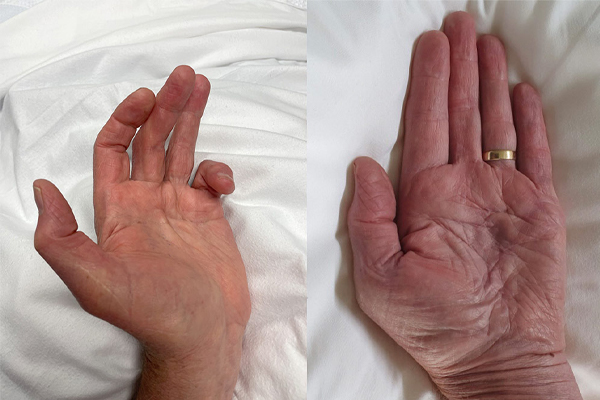Dupuytreins Contracture Correction
Dupuytren's contracture correction is a treatment for a condition in which the fascia (connective tissue) in the palm thickens and tightens, causing one or more fingers to bend towards the palm. The goal of treatment is to improve hand function and relieve discomfort.
Why Treatment is Needed
- Difficulty in performing daily tasks, such as gripping objects or shaking hands.
- Progression of contractures that worsen over time.
- A significant impact on quality of life or occupational duties.
Treatment Options for Dupuytren's Contracture
1. Non-Surgical Treatments
- Needle Aponeurotomy (Needling):
- A minimally invasive procedure where a needle is inserted under the skin to cut the thickened cords.
- Quick recovery but a higher chance of recurrence.
- Collagenase Enzyme Injections (e.g., Xiaflex):
- An enzyme is injected into the cord to weaken it, followed by manipulation of the hand to straighten the fingers.
- Effective for mild to moderate cases.
2. Surgical Treatments
- Fasciectomy:
- The thickened cords and affected fascia are surgically removed.
- Suitable for severe contractures.
- May involve skin grafting if extensive tissue is removed.
- Dermofasciectomy:
- Removal of both the fascia and the overlying skin.
- Reduces the risk of recurrence but requires more recovery time.
- Limited Fasciectomy:
- Only the most affected tissue is removed to preserve hand function.
3. Physical Therapy and Hand Therapy
- Often recommended post-procedure to regain hand strength, flexibility, and functionality.
- Includes stretching exercises, massage, and splinting to prevent contractures from returning.
Procedure and Recovery
Before the Procedure
- A physical examination to assess the severity and determine the best treatment option.
- Imaging or tests, if needed, to plan the procedure.
During the Procedure
- For minimally invasive options, the procedure may be done under local anesthesia.
- Surgical treatments are typically performed under regional or general anesthesia.
After the Procedure
- Splinting may be required to keep the fingers straight during healing.
- Physical therapy helps regain motion and strength.
- Avoid heavy lifting or gripping until cleared by the doctor.
Risks and Complications
- Recurrence of contractures (common with non-surgical methods).
- Infection or delayed wound healing.
- Nerve or blood vessel damage during surgery.
- Stiffness or reduced hand strength post-treatment.
Who is a Candidate?
- People with progressive contractures interfering with daily life.
- Those with a noticeable bend in one or more fingers (typically greater than 30 degrees).
- Recurrence cases after previous treatment.



